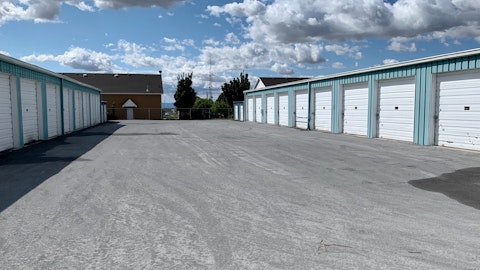U-Haul Holding Company (NYSE:UHAL) Q3 2024 Earnings Call Transcript February 8, 2024
U-Haul Holding Company isn’t one of the 30 most popular stocks among hedge funds at the end of the third quarter (see the details here).
Operator: Good morning. My name is Laura, and I will be your conference operator today. At this time, I would like to welcome everyone to the U-Haul Holding Company Third Quarter Fiscal 2024 Investor Conference Call. All lines have been placed on mute to prevent any background noise. After the speakers’ remarks, there will be a question-and-answer session. [Operator Instructions] Thank you. Mr. Sebastian Reyes, you may begin your conference.
Sebastian Reyes: Good morning, and thank you for joining us today. Welcome to the U-Haul Holding Company third quarter of fiscal 2024 investor call. Before we begin, I’d like to remind everyone that certain of the statements during this call including without limitations, statements regarding revenue, expenses, income and general growth of our business may constitute forward-looking statements within the meaning of the Safe Harbor provisions of Section 27A of the Securities Act of 1933, as amended, and Section 21E of the Securities Exchange Act of 1934 as amended. Forward-looking statements are inherently subject to risk and uncertainties, some of which cannot be predicted or quantified. Certain factors could cause actual results to differ materially from those projected.
For discussion of the risks and uncertainties that may affect the company’s business, and future operating results, please refer to the company’s public SEC filings and Form 10-Q for the quarter ended December 31, 2023, which is on file with the U.S. Securities and Exchange Commission. I’ll now turn the call over to Joe Shoen, Chairman of U-Haul Holding Company.
Joe Shoen: Well, thank you all for joining us again for our quarterly report. There have been few positive signs in the consumer demand for either truck sharing or self-storage rentals. Our U-Box continues to grow, but it is simply too small a part of the total market to be considered as an indicator of moving and storage demand. We are making some modest progress in backfilling the voids created in our fleet by vehicle manufacturers unwillingness to build sufficient truck product basically since the beginning of COVID. This will take several years to work its way completely through the fleet assuming someone will build trucks. We continue to build and buy self-storage. I believe the right locations managed over a period of years are a good investment for the company.
Everybody has their own opinion of what’s going on in this market. Rising costs continue to pressure U-Haul and our customers. We are often unable to accurately predict future costs or to hedge them. My strategy is to try to absorb all legitimate costs into the present period rather than try to postpone them into an uncertain future. Our insurance subsidiaries are solid. Mark Haydukovich, the President and Chairman of our Oxford Life Insurance Group, will be retiring this quarter after 45 years of leadership for this company. Mark will remain on the Board of Directors. I’ll now pass the call to Jason Berg for some analysis of the numbers.

Jason Berg: Thanks, Joe. Yesterday, we reported third quarter earnings of $99 million compared to $199 million for the same quarter last year. This translates to earnings per share of $0.51 for non-voting share this quarter compared to $1.02 per non-voting share in the third quarter of last year. Beginning with equipment rental revenue results compared to the third quarter of last year, we had a $59 million decrease, which is about a 7% decline. Over the last 18 months, we’ve had a $379 million decrease in U-move revenue, giving back a portion of the $1.4 billion of increases we experienced the eight quarters before that. To give you a better sense of how much of those revenues we’ve maintained so far compared to the last quarter of the pre-pandemic called the third quarter, which ended December 31, 2019, we’ve increased our third quarter revenue results by over $218 million third quarter two years ago to today, or on a compounded growth basis, I’m sorry, four years ago by nearly 8%.
Average miles per transaction continue to decrease as customers are using our equipment on shorter mileage moves. On a positive note, whereas transactions for the nine months are down a little over 3%, for the quarter we were down just over 1%. And in fact, while we still had a revenue decrease in the month of December, transactions increased around 1% in the month. Unfortunately, we lost a bit of momentum in January as our results were undoubtedly affected by tough weather. Capital expenditures on new rental equipment for the first nine months were $1,350 million. That is a $334 million increase compared to the same period last year. We’ve increased our fiscal 2024 full year net CapEx projection from $870 million to approximately $930 million.
So that’s gross purchases net of proceeds. Proceeds from the sales of retired equipment are up $68 million for the nine months to a total of $595 million. The increase in proceeds is coming from additional truck sales. Average sales price per unit has been steadily declining. At our current pace this year, we should make maybe a 2,500 to 3,000 truck dent in our rotation backlog and our teams have been increasing the pace of truck retirements, taking out older equipment. For self-storage, revenues were up $20 million, or 11% for the quarter. We increased the total number of occupied rooms and were also able to improve average revenue per occupied square foot by almost 4%. The year-over-year improvement in revenue per foot has been coming down as we progress through the year.
Our occupied unit count at the end of December was up nearly 29,000 units compared to the same time last year. Over that same time frame, we’ve added 42,000 new units into the inventory and it’s this differential that’s led to our average I’ll call it all-in occupancy ratio during the third quarter to decline to 82%. This same moderation in occupancy can be seen in the same-store grouping of these properties that we put in our press release with an occupancy decrease of 210 basis points to 92.9%. Our asking rents for new customers on average across the entire portfolio are up a little less than 3% year-over-year. During the first nine months of this year, we’ve invested $969 million in real estate acquisitions along with self-storage and U-Box warehouse development.
That’s a $35 million decrease over last year. Spending on acquisitions of new properties has declined, while investment in development of existing properties that we own has increased. During the quarter, we added a little over a million new net rentable square feet and we have just under 8 million square feet being actively worked on. Operating expenses at moving and storage increased $37 million for the third quarter. First, the good news from the quarter was that the fleet repair and maintenance was down $3 million. Conversely, we had a $13 million increase in personnel and the quarter also included approximately $17 million of costs that I would consider non-recurring in nature, including a large vendor rebate that we netted against costs last year.
That was a one-time event. Combined with some credit card accrual charges that were recorded this year that I would not expect to recur. Property taxes also were up about $4 million. We have made progress in deploying some of our cash balances to new investments, but we still intend to remain conservative in regards to cash and liquidity as of December 31 this year – 2023, cash along with availability from existing loan facilities at our moving and storage segment totaled $2,211 million. With that, I would like to hand the call back to our operator Laura to begin the question-and-answer portion of the call.
See also 15 Best East Coast Cities to Retire on a Budget of $1,200 a Month and 25 Countries That Gave the Most Foreign Aid in 2023.
Q&A Session
Follow U-Haul Holding Co (NASDAQ:UHAL,UHALB)
Follow U-Haul Holding Co (NASDAQ:UHAL,UHALB)
Operator: Thank you, sir. [Operator Instructions] Our first question comes from the line of Steven Ralston from Zacks. Please go ahead.
Steven Ralston: Good morning.
Joe Shoen: Good morning.
Jason Berg: Good morning.
Steven Ralston: I actually only have one question, and I’ll preface it by saying the top line to me is roughly in line with expectations. It follows what management has been saying, and what I also believe is that you’re still on your historical growth rate after the blip up that caused by the pandemic. And given the economic environment, it’s consistent with that premise. It’s something I mentioned in the last earnings call. I have a quite detailed earnings model, and everything seems to be in line except this one particular metric that I monitor, and that’s looking at the operating expenses for moving and storage, and it’s the margin for that. So you divide it by the revenues of the self moving equipment rentals, and it’s popped up considerably.
And I have not been following U-Haul for a very long time, only five years, and it’s the highest margin or level of expenses relative to revenues in the previous five years, I looked at the 10-Q, and you do mention it. Its – you attributed to personnel costs, property taxes and building maintenance. And as you just said, property taxes only went up $4 million, which doesn’t account for that increase in margin. So I’m sort of concluding it’s in personnel costs. It seems like it’s inflationary in nature, and I just like you to dive a little deeper into these operating expenses and what’s driving this increase, because the third fiscal quarter is relatively a clean quarter, given its seasonal slowness relative to some of the others.
And it just kind of sticks out at me that this operating expense number is accelerating higher than normal.
Jason Berg: Well, I’ll start with that. This is Jason. So first, our largest expense, personnel costs, that’s been more of a function of the decrease in revenue. And there has not been a coincidence decrease in personnel costs. We’ve tried to become a little more efficient at the home office with staffing, and the headcount this year is only up about 2%. So we’re not growing the size of the personnel so much. That’s more a function of the revenue just has been coming down, and we have the capacity for more business. The repair and maintenance this quarter compared to last year is down. If you were to go back four years, it’s up probably $70 million on a quarterly basis. So that’s still higher than what we would expect.
As we put on the new equipment and you see the depreciation expense claim associated with the new equipment, you would normally expect them to see the repair and maintenance come down and the utilization of the fleet increase. And both of those have been lagging this time around. Then I did point out in the comments there are about a little over $17 million of what I would say are kind of non-recurring costs in this quarter. But I think you’re speaking to a trend a little bit more than just this quarter.
Steven Ralston: Yes. I mean everything else is – the quarter is actually pretty good considering the environment and what you’re dealing with. I’m just looking at this personnel cost. Well, I guess it might be something else. The 2% is that the headcount or is that the expenses? In other words, you might have to be paying with employees a higher level of compensation in order, in environment.
Jason Berg: That was headcount.
Steven Ralston: That was headcount. Okay. Are these compensation going up higher than usual?
Jason Berg: I wouldn’t classify it, higher than usual. It’s been going up the last several years on a per hour basis. I think for the nine months, I think we’re up somewhere close to $8 million to $10 million on medical benefits and the rest is wage activity.
Steven Ralston: Okay. Well, thank you for answering my question. And all in all, good quarter. I just have a little concern about the expenses. Thank you.
Jason Berg: Thank you.
Operator: Question comes from the line as Keegan Carl from Wolfe Research. Please go ahead.
Keegan Carl: Hey guys, thanks for the time. I guess I’ll start with a question I asked last quarter too, but just trying to think on a like-for-like basis, what you think the self moving equipment rentals would have been down if you removed the new stores, you would have added year-over-year. And I guess more broadly, how does that compare to the prior quarter? Are you seeing any sort of sequential improvement?
Joe Shoen: I don’t know if Jason has a number, I would say probably 1% or less. That’s a very – its – you can’t get as hard a number on that as you might think you’d be able to get. But – so kind of another way to phrase that question is, did the new stores cannibalize same-store sales or were they additive? And I think they were probably about half the revenue they generated was additive. So that’s going to be kind of my – but I can’t give you a hard number on that. But that’s something of course, to be concerned of. As you know, we also go to the customer via what we call a U-Haul dealer and so trying to balance total revenue, and then the source of that revenue where the customer encounters the product is of course, a concern and something we watch.
And stores did a little bit more of the business than they did a year ago. So in a sense, you could say they cannibalized a little bit into dealer business. So to – if we had stripped the stores out and hadn’t done them, I think we might have seen a percent maybe. Maybe not that much. I don’t know, Jason, what do you think?
Jason Berg: Every couple of years we do a study of this to see what happens when we put a new company location in and the effect that it has on dealers. That hasn’t been done now for a couple of years, but what we have found historically is that the entire market ends up coming up after we put a company location in. So my generalized response to that is it doesn’t – it shouldn’t have a big negative effect. And I haven’t seen a market where we’ve put a company location in where the overall market has gone down. Its always – everyone I’ve ever looked at, it’s always gone up.
Keegan Carl: That’s really helpful. I guess shifting gears just specifically in the self moving business in January, I know you mentioned it was – it didn’t have an easy month, but also weather related. I guess I’m just curious, maybe as we work through that, are you seeing any incremental improvements? I know it’s early in February, but just trying to get a better feel for, I guess, how you’re expecting that portion of the business to trend throughout this quarter.
Joe Shoen: Of course, hope springs eternal, and of course, anybody who tells me the weather caused them to be down in business basically gets a tongue lashing. So we’re not relying on that. But if you – I think that, that, that we really did have some of that. We had a pretty decent first 10 days of February, but February is another one of those months, the son of a gun. Every six or seven years, we get slaughtered either in January or February. We got slaughtered in January. Could we get slaughtered in February? It still could happen. California had just had another run of nasty weather. But so far I’m – but again, I’m hopeful constantly. So I may be the wrong person to say, but it doesn’t look like there’s anything negative in the market other than weather.
In other words, there’s not a competitive force happening. People, as Jason commented, are driving fewer miles, and we’ve seen this over 40 years. When people are uncomfortable with their economic certainty, they tend to drive our truck shorter distances. Its – we’ve seen that repeat and repeat. And there’s a some kind of a little malaise, kind of over consumers heads right now that I don’t have an explanation for totally. But until that kind of turns to a little bit more positive view. I don’t expect them to drive more miles. Now, I don’t think we’re losing long rentals to competitors. We look at those kind of things. We don’t see that happening. We just see that people are just a little hesitant. And when they get that way, it’s kind of logical.
They don’t want to move as far. They don’t want to – they’ll still move because they got married, but they just don’t move to a distant city. So all these things that drive business, these life events, they continue on, but they’re not quite as adventurous as they might have been when they were more – they just felt more positive about their circumstance.
Jason Berg: In this case, if I could just – I think people’s definitions of slaughter might be very – for us…
Joe Shoen: That’s not an accounting term. Okay.
Jason Berg: Probably closer to say like a 5% or 6% decrease.
Keegan Carl: No, that’s really helpful. I guess, one specifically for Joe, the press release, I actually thought the commentary was pretty positive in the beginning. You mentioned that you’re seeing pockets of modest growth in certain markets and product lines. Just maybe go into some more detail on this. And then what markets in particular you’re seeing improvements in?




